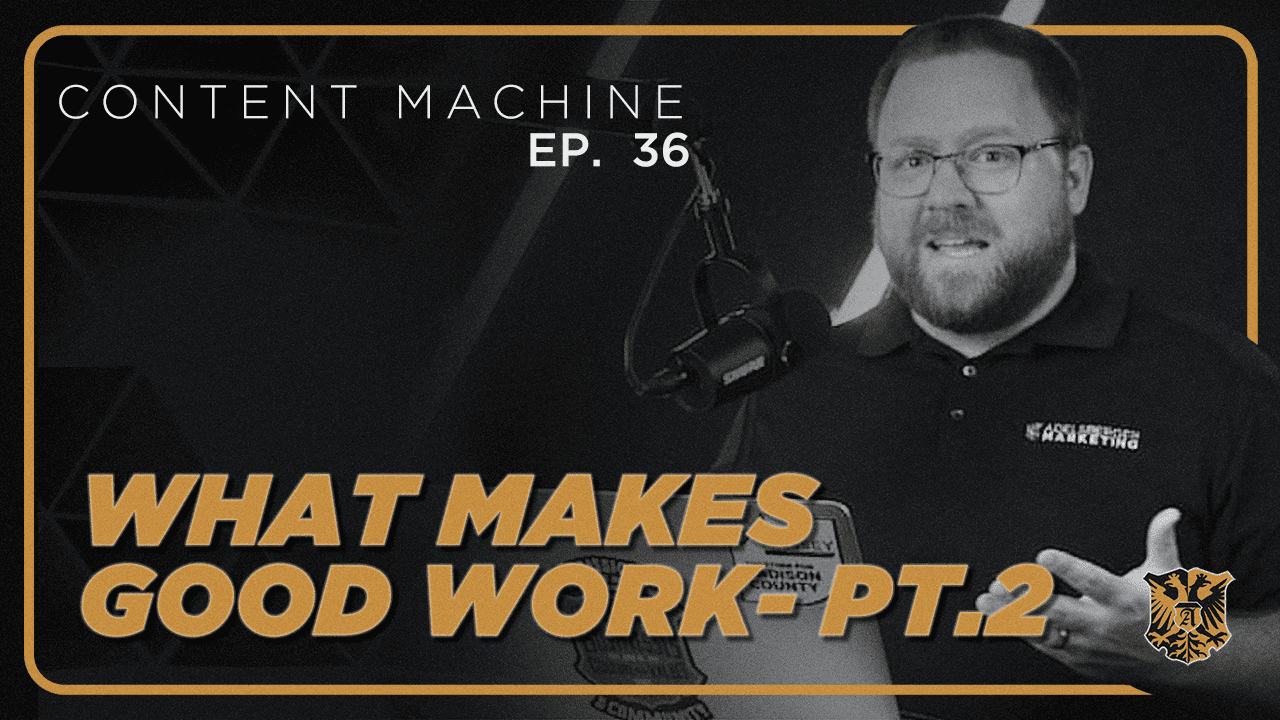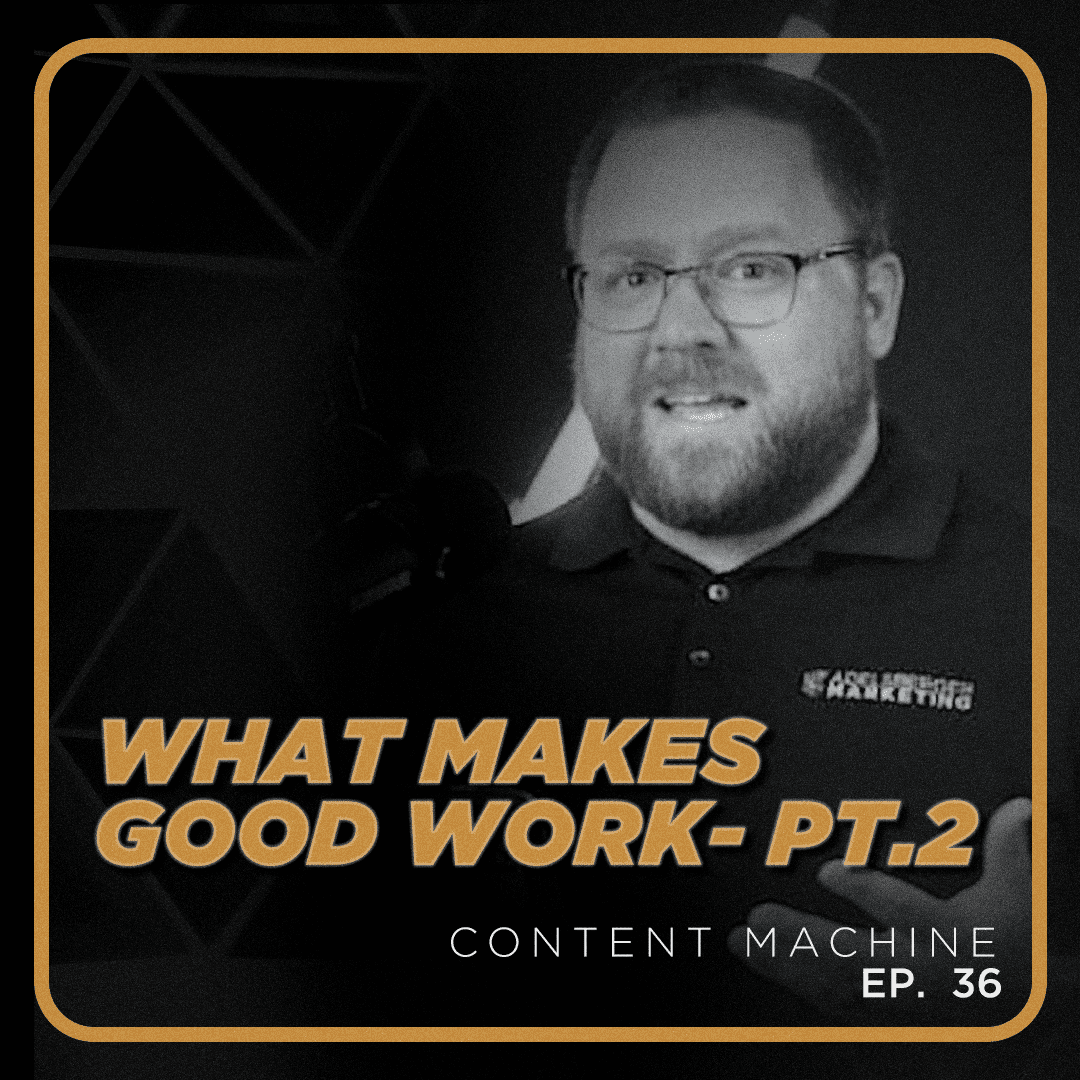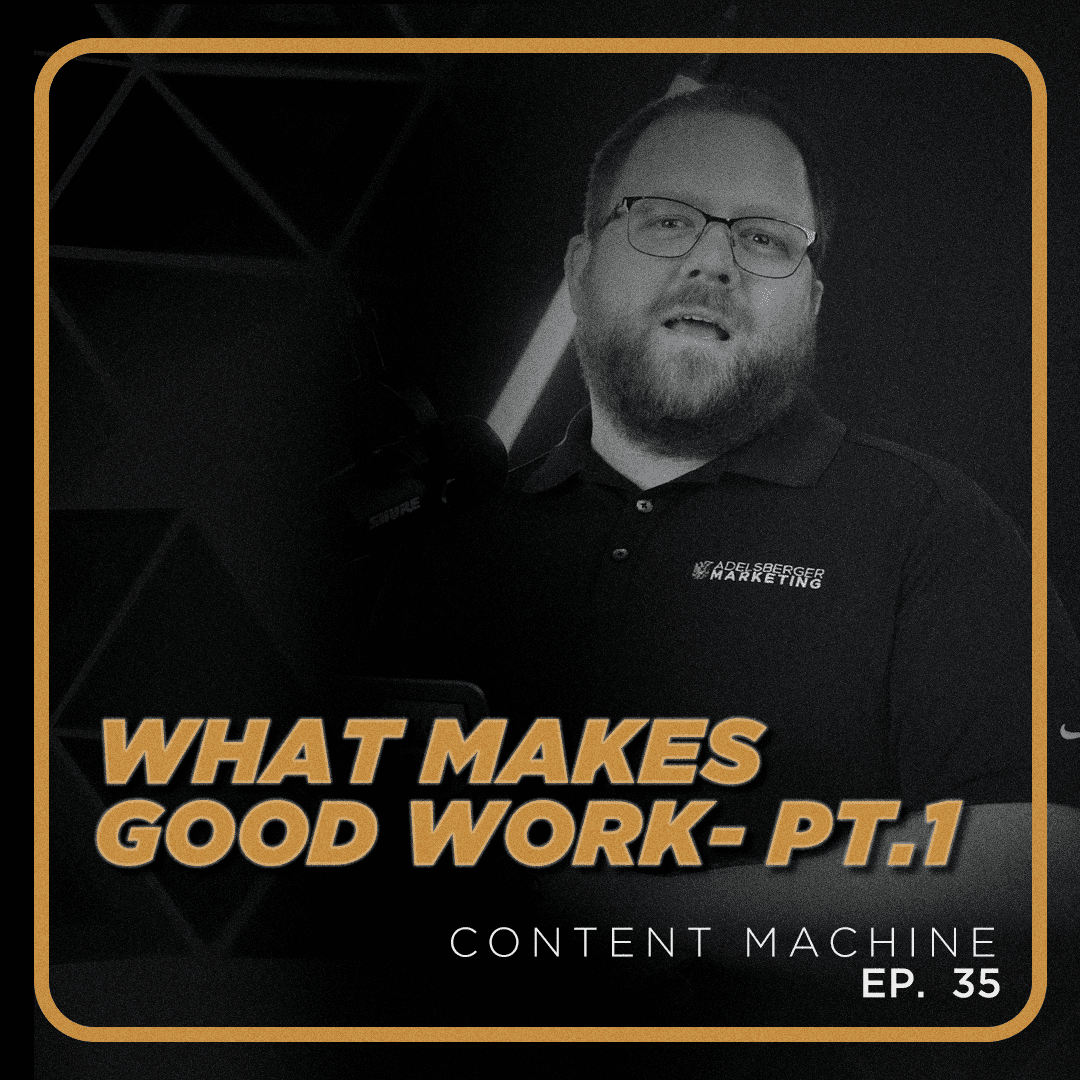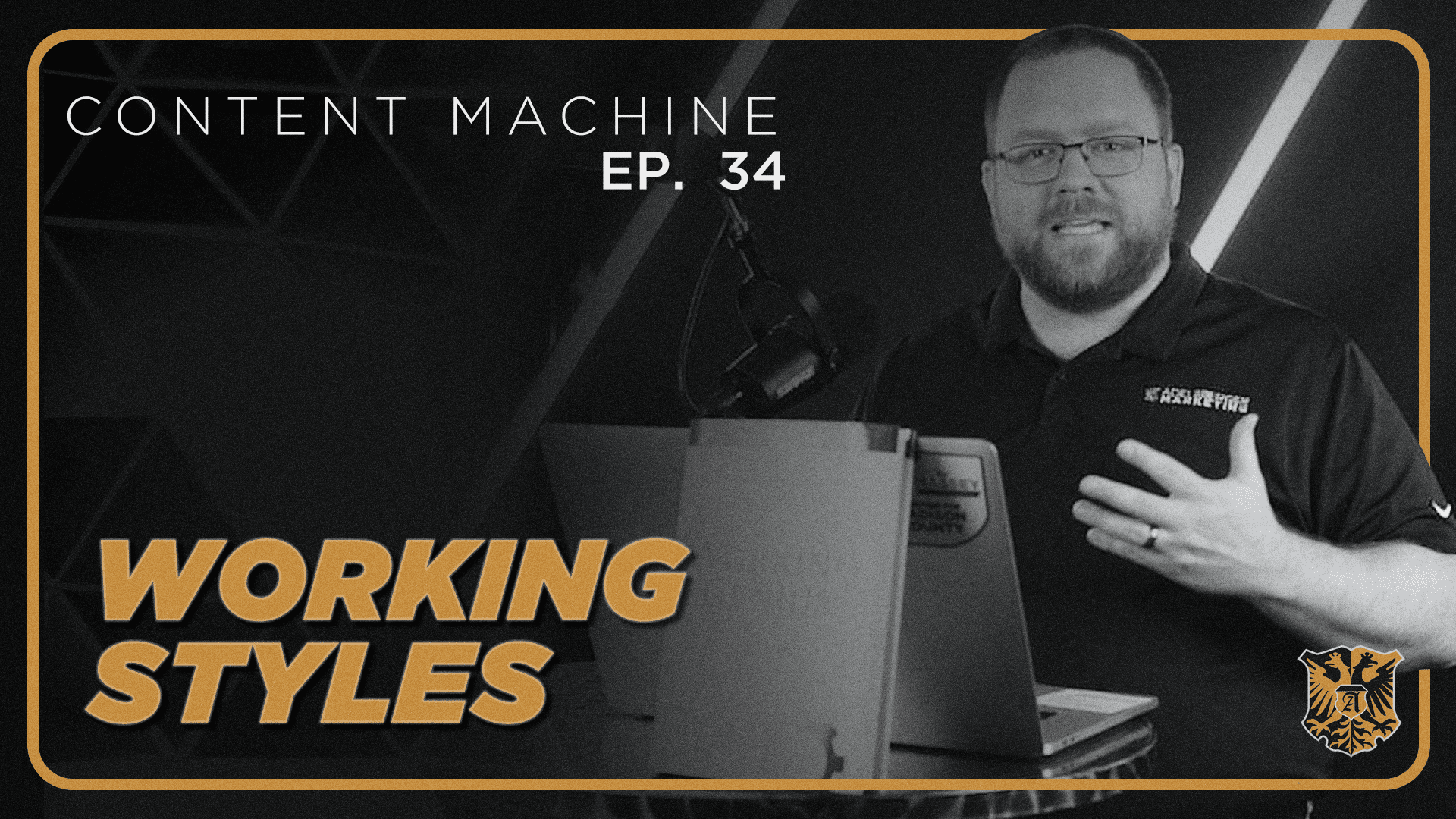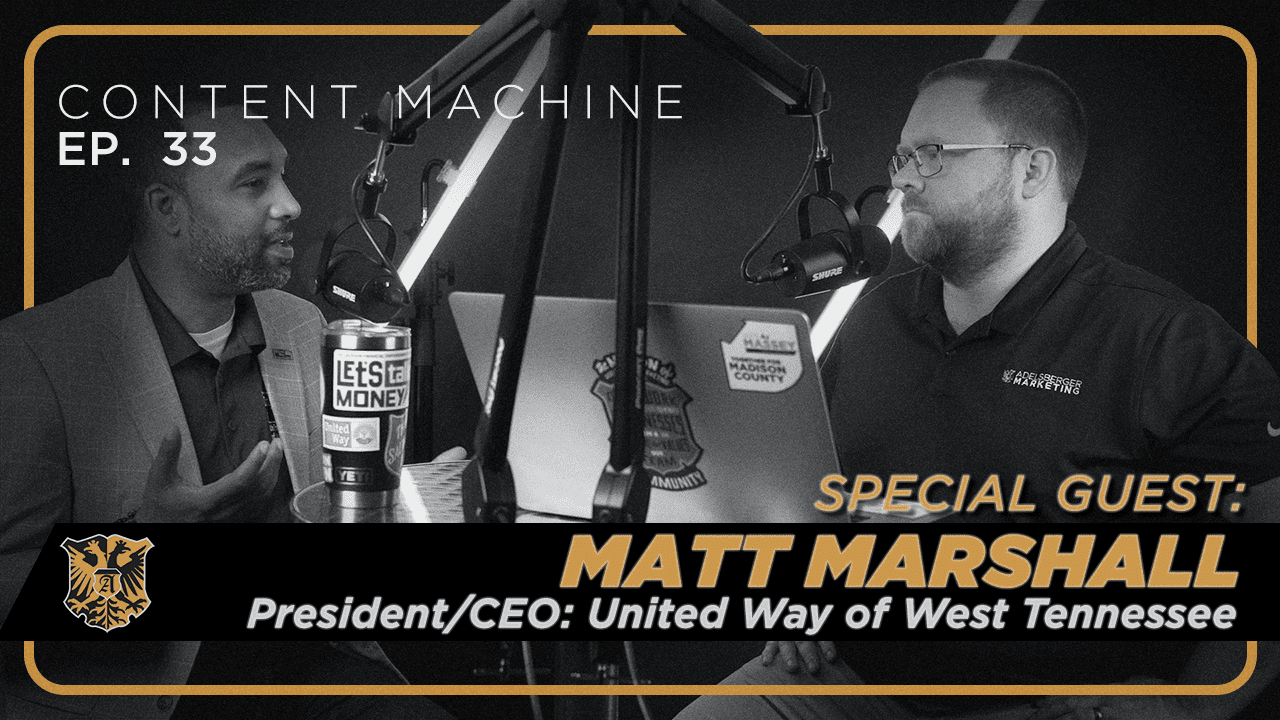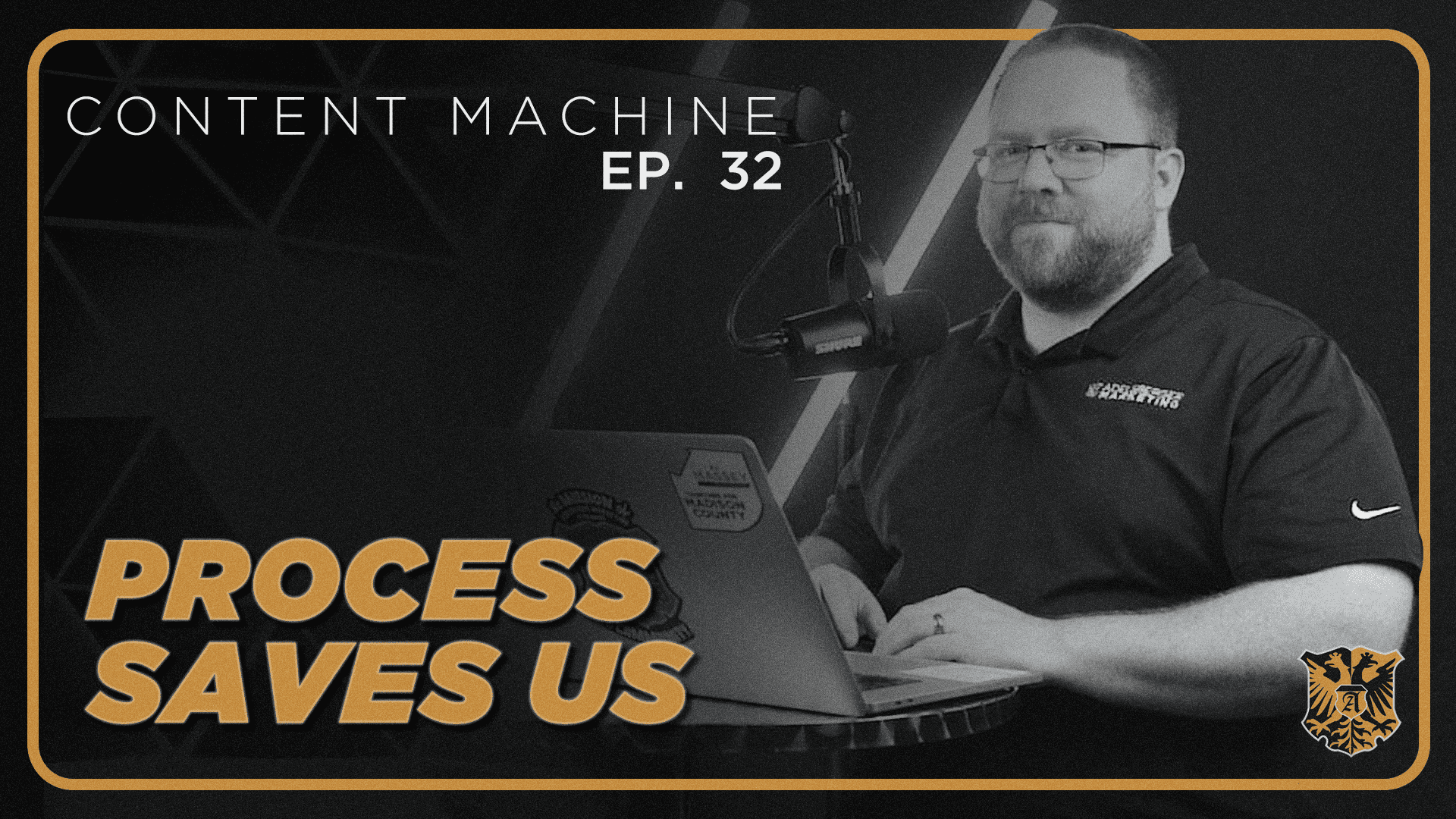Thank you for listening to the Content Machine Podcasts. This is part two of our interviews with Matt Marshall of the United Way.
Well, so you come in and you start pretty quickly changing the dynamic of what it’s done for forever. From a leadership perspective, how are you working on that change with the team? How are you communicating that? Did you have push back? How does that go down?
Yeah. It’s been an interesting, I think, transition for sure. What happened was right when I first started, obviously, I had interview with the board and explain what I hoped the vision for the organization could be. But as I had our very first staff meeting, I just walked into that staff meeting and I just sat down with the staff and asked them, What do you need from me? What do you need from me from this leadership position? What would you like to see? And all those types of things. That really was the genesis of all the rest of it and in that transition because one of the things that communicated at that meeting was the same thing that I had already picked up on. There were some areas of need in the community that they felt like we could address. Now, I’m not going to sit there and say that any of us at that time knew what that was. It wasn’t so much that as much as it felt like we could do more. And so over the course of the next several months and next year or so, we just continued to have those conversations and delve deeper into what does that mean?
And again, things like the Alice Report really helped us to identify that. And then the services we were providing through the pandemic also played a role for sure. If anything, I think I’ve always said to everyone, a lot of the work and the thought process that went into those first early months on the job, late 2019, early 2020, we already had begun to identify where we really wanted to go. We weren’t sure how we were going to get there, but we had figured out where we wanted to go. And what we felt like ended up happening, rather ironically is that the pandemic really put these thrusters to that and just it exposed… It’s like the Warren Buffett quote, “When the tide goes out, you say you’re swimming naked.” That’s right. It exposed, shows so many things that were maybe hidden by the economy or things like that.
I think one of the things that the pandemic naturally did was it highlighted need in our community even more. And so it helped clarify for us, okay, yeah, this is where we need to be investing. So early on, those were the feelings we had. And so over the course of time, as you’re working with the staff and you’re trying to identify, okay, what does this really practically mean on a day to day basis? I think a lot of I don’t really sense any real moments of real push back, not at all. If anything, I felt always a very strong sense of excitement and enthusiasm from our team on direction and where we were going. I think a lot of that was because I’m very team oriented in terms of those types of things. And so, yes, I may have initial thought or a vision for something, and I really love vision casting. That’s definitely where I love to sit. It gets hard for me, the details of all the stuff. That’s where I have to have awesome people around me to help with all of that. But yes, I would walk into the room at times and just have this vision for something, but the process of fleshing that out was always a team project, and I very much welcome that. I think it allow for the staff and the board to feel a part of that process. This was our vision. It wasn’t Matt Marshall’s vision. It was United Way’s vision on how we get there.
There’s a little bit of that that’s going to be more engaging because you’re doing something new that’s requiring buying as opposed to just doing the same old thing again and again. That’s right. It gets people really heavily invested. You have been leading for a couple of years now. When you think about how to brand and market the United Way, how does that thought process work for you?
I’ll go back to… I don’t think we’ve solved this issue yet, if I’m honest. I think we have taken some great strides. But the key problem I walked into… So my first week, all I did was watch a ton of webinars and conferences and all this type of stuff from United Way, worldwide and from all over the United States talking about United Way. I tell everyone, I just was two days into that and I was like, Oh, I see the problem. As I alluded to earlier, no one could tell you what United Way does. The vast majority of people. I tend to separate this out by generations and by age groups because I think if you were to ask someone, generally speaking, who’s 50 or older, they probably could. But if you were to ask someone, generally speaking, what we may be referred to as your Gen Xers, your millennials, and for sure now Gen Z, who is United Way, your Gen Xers would say, Yeah, we’ve heard of United Way and we could tell you maybe what they do. Your millennials would say, I’d say only 50 % of them might say that they’ve heard of United Way, definitely couldn’t tell you what they do. And I’d say most of your Gen Z would be like, Never heard of United Way, have no clue what they do. Millennials recognize the logo. They probably get that. And so Gen Z might not even get that far. And so that’s been the core issue is like, okay, the marketing problem is just that itself, like, brand recognition. And so we actually just from United Way Worldwide did a huge national survey on all of this and looked at the data, and it was really interesting. And so for me, hyper localize that. Our issues are the same just as pretty much anywhere else. Decent brand recognition. People who do know us, have respect for us and trust us, generally speaking. But again, the vast majority of people couldn’t tell you what we do. Or even if they could, they have question marks because many of them would say we sound like a middle man. And I don’t think they’re exactly wrong. And so we don’t want to be just a middle man, right? Yeah, it’s a bad place to be. Yeah, it’s a bad place to be. But it’s like, but how can we be more than that?
And so a big piece of marketing has been trying to figure that out. How can we change the way people view our work and view the impact we’re having in the community? How can we create great stories from the successes of that impact that we’re having in the community, both through our partner agencies and through our direct programming now, how can we get people excited about what United Way is doing and want to be a part of that? And so all of our marketing strategies have been geared around trying to solve those problems, trying to answer those questions. And so, again, I think we have grown by leaps and bounds over the last three and a half years in relation to that. But I would be really honest to say we’re still far from where I think we could be.
And when you’re introducing your new concepts, do you feel like that muddies the water even further? Or how do you feel like that plays in?
Yeah. No, I actually think… And the only reason I can confidently say no is because we spend a lot of time thinking and talking through it. I think it has the potential to do that, right? So as an example, as a nonprofit of nonprofits, there could be folks who just might say, you just need to do what you always did. And maybe you should back up at this point and say, Well, why didn’t we just continue to do what we’ve always done? Well, it wasn’t working anymore. If I’m just going to be blatantly honest, it wasn’t working. Our donations over the past 20 years had just been on a steady decline. And so we were getting less and less donations, which matter not only to our organization, but more importantly to all those organizations we support. And so we want to be able to provide as much funding and backing for them as we can. But if their donations are just steadily going down, well, eventually it’s going to hit the fan and we’re not going to be able to do that anymore. And so we had to shift in some way. And so part of this, the problem we’re solving for is not only… And I’ve said this from day one, I’ve been really honest with all the nonprofits and with the community. When we started our own programs, I didn’t say, Hey, we’re going to start our own programs, and we’re just not going to do that old stuff anymore. No. We said from day one, I want to raise more money for all of our nonprofit partners and raise money for these programs because they’re both needed and need that support. And so, yeah, it could have been bad, right? It could have. But I think how we’ve been able to really do that fairly well is by growing support for the other nonprofits, too. Starting a West Tennessee Nonprofit Network, starting a giving Tuesday 731, where we help those nonprofits raise money on giving Tuesday, have the newsletter going out to all the nonprofits and to the community about all the different things that are happening, not just with United Way, but everybody else. It’s providing all that general support at the same time that we’re also trying to raise up these solutions for these other community issues. I think we’ve done a pretty good job of that. And where I see proof in that, because you could ask that question, Well, how do you know? How do you know if you’re doing a good job? Well, again, and I say this truly with all the humility in the world because it’s not about me and it’s about our team and it’s about more importantly, the community because they’ve done this. And this is what I said at the celebration breakfast a couple of weeks ago. We just had our largest ever fundraising year in the 81 year history of United Way. That’s a huge deal, right?
It’s a huge deal. That’s a huge deal.
And I think that lends credence to people are getting excited about this work. Again, they’re getting excited about our brand. They’re getting excited about the things we’re doing. And that’s the community. That ain’t me. That’s not United Way. That’s the community. And again, it’s just about how can we figure out how to insert ourselves into the Jackson and West Tennessee’s sight guist? The spirit of the times to help people understand what we’re doing and how they can be a part of that.
Yeah. And I bet there’s a strong correlation between people who stopped doing United Way campaigns and then stopped giving altogether.
Probably so.
Yeah. Because it’s a little bit on autopilot. That’s right. So probably the net donations go down and the United Way is great at helping funnel those things. Well, you’ve answered the rest of my questions in that one question. So, Matt, we appreciate your time to come on here. Appreciate what you’re doing for West Tennessee. And if people want to know more about the United Way or want to get involved with the United Way, what should they do to do that?
Absolutely. So there’s so many different ways they can get involved. So I’ve only talked about this many of our programs so far. One’s I didn’t mention that are awesome programs. And the first one I’ll mention that you can get involved with today is the Read Seen program. And so we recruit volunteers from all across Madison County, specifically, we look to grow this program into other counties here in the coming years. But those volunteers then go into the school system and read and help kids increase their literacy scores, which is so incredibly important. And so we are always looking for more volunteers to help with that process. But people can also get involved in some other things that we’re doing. So we hired some tutors on another program called Tutor U this summer that will also be executing over the course of the next school year, both here in Madison County and also in Haywood County. People could sign up to be a volunteer for that. The difference between Reed team and Tutor U, Reed team is more based on sight words, and Tutor U is based on phonetics. So it requires a little bit more training on the phonetic side, but both excellent programs. We want to tackle that from both sides to give students the best chance at reaching those levels that we need them to reach for our test scores across the state and all that type of thing. That’s just an example of how people could volunteer.
But we always say you can give, advocate, or volunteer with United Way. Everybody can do one. If you don’t have time to volunteer, maybe consider advocating alongside us for these needs in our community. And if you don’t have the time to advocate, but you have resources, consider giving. And again, that can go directly to our programs, but also that can go to dozens of agencies here in West Tennessee that you care about as well. And so everybody can do one of those things. They can find out more information about United Way by going to uwwt.org. Go online, learn all about our programs, learn all about the agencies we support, learn about the things that we’re doing and the things that are coming up and get involved with that. They can follow us on social media, Facebook, Instagram, Twitter. We have a YouTube page as well where we have some videos up there about stuff we do.
And then, of course, they can connect with Adelsberger Marketing and everything that’s going on with them because we’re friends and you talk about us sometimes too. You wear our United Way shirt and you rep us.
Matt, thank you for your time and I hope you all will go help the United Way.
Thank you.
Thank you for listening to part two of our podcast with Matt Marshall from the United Way. We hope you’ll go check out the United Way and listen to future episodes of the Content Machine Podcast.

